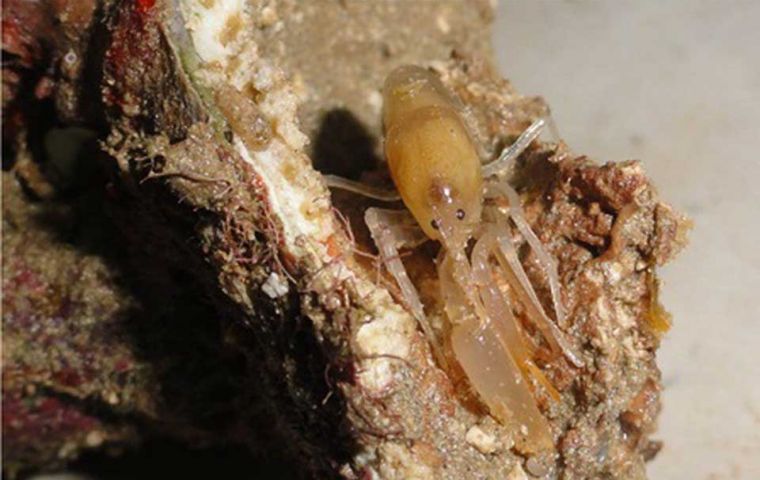MercoPress. South Atlantic News Agency
Brazilian researchers discover new shrimp species
 Genetic testing confirmed it was in fact a new species (Pic UFPE)
Genetic testing confirmed it was in fact a new species (Pic UFPE) Brazilian scientists from the Federal University of Pernambuco (UFPE) have detected a new species of buffalo shrimp which they named Alpheus Coralvivo after the Living Coral Project, it was reported.
The crustacean was said to live on coral reefs off Brazil's northeastern coast. It was found in cavities in the limestone skeleton of fire coral and inside coral gravel on the south coast of Bahia and Río Grande del Norte.
The Living Coral Project initiative has for more than two decades contributed to the preservation and conservation of marine communities, especially coral reefs.
The scientists reviewed the animal's morphology and compared it with other species nearby, in addition to conducting a genetic test that corroborated it was indeed a new species.
“This discovery expands the data on known animal biodiversity in Brazil and around the world, and also helps in conservation studies of marine species,” said researcher Patricia Souza dos Santos, a professor in the Animal Biology Postgraduate Program (PPGBA) at UFPE.
The term “stalked shrimp” applies to marine shrimp of the alpheid family, which are usually found among rocks or in holes. The name stems from this shrimp being one of the most developed chelopods which, when they feed, produce a snap as well as a shock wave that can kill their prey.
Souza dos Santos' article ”Morphology and molecular evidence reveal hidden diversity among the Alpheus obesomanus group (Decapoda: Alpheidae) with the description of a new species in Brazil“ states that the new species was identified after analyzing material collected by hand and by diving.
The researchers discovered it at a depth of 12 meters in the coral reef region of Porto Seguro, Santa Cruz Cabrália and Abrolhos, in Bahia, and Parrachos de Maracajaú, in Río Grande del Norte.
”The registration of a new species is an important fact in itself. Much more so when it comes to the marine environment, which is still little explored in relation to the terrestrial one. With every study, new scientific findings are revealed,” Souza underlined.
The study was carried out jointly by the UFPE's Crustacean Biology Laboratory (LBC) and Carcinology Laboratory of the Federal University of Rio Grande do Sul (UFRGS), of Biotechnology and Systematics of Crustaceans of the Faculty of Philosophy, Sciences and Letters of Ribeirão Preto (FFCLRP/USP) and of Environmental Genomics of the Federal Technological University of Paraná (UTFPR), all of whom were funded by agencies such as Facepe (APQ-Facepe), CNPq (Edital Universal) and Fapesp (Projeto Biota Fapesp), it was explained. (Source: Diario de Pernambuco)




Top Comments
Disclaimer & comment rulesCommenting for this story is now closed.
If you have a Facebook account, become a fan and comment on our Facebook Page!